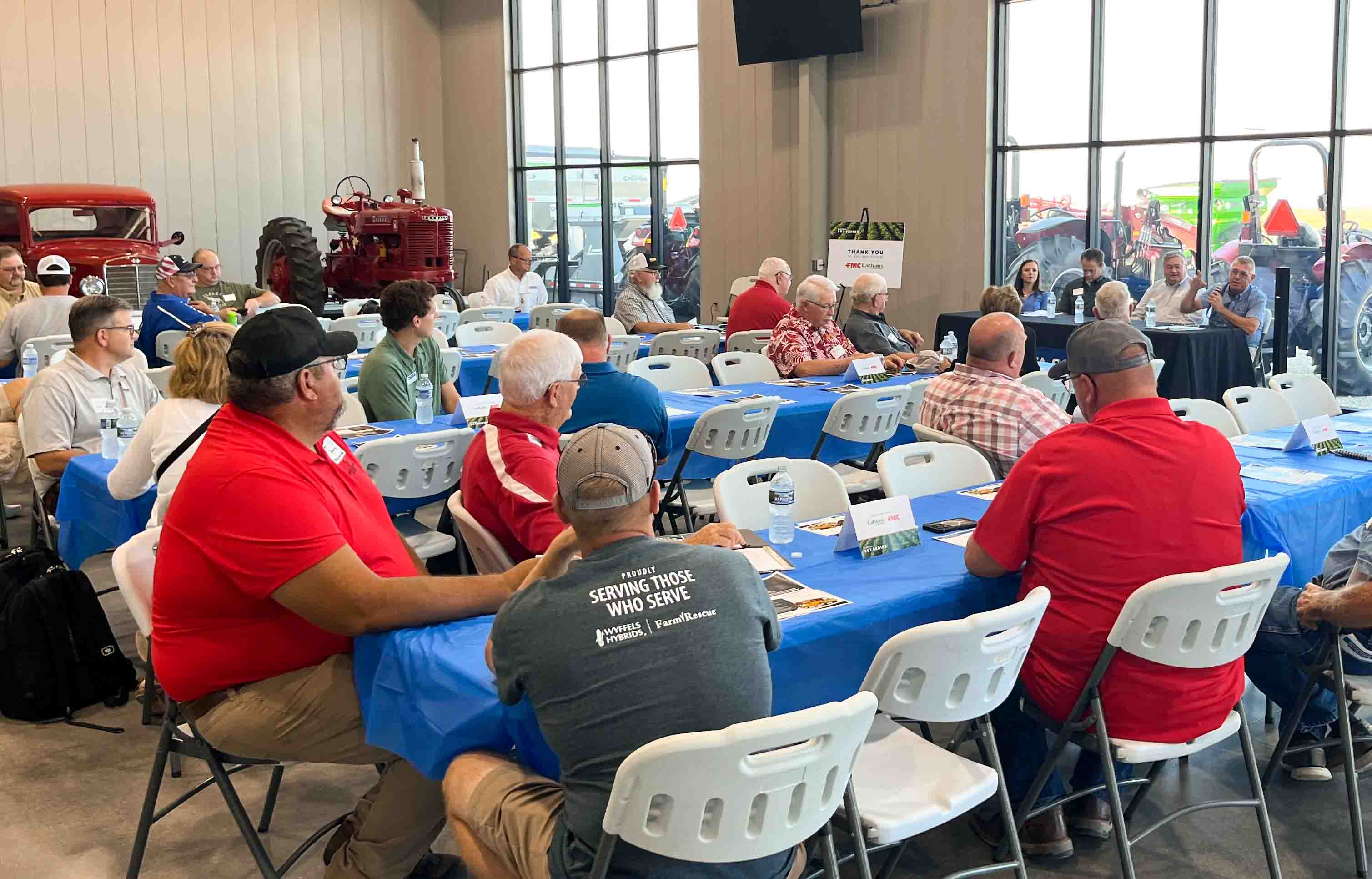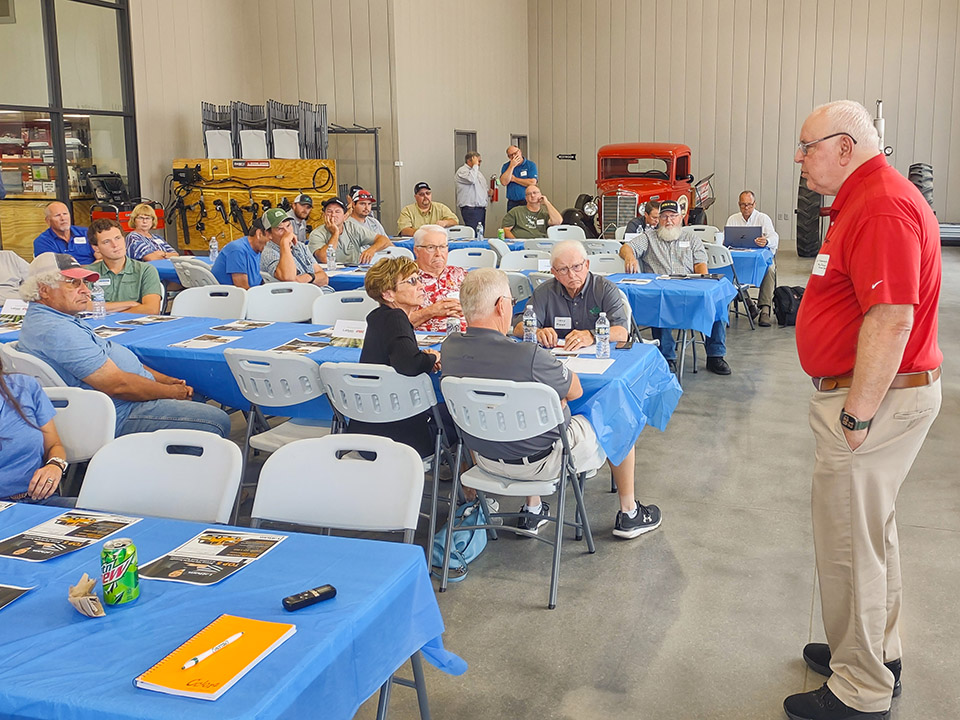
(Photo: Iowa Soybean Association / Kennady Moffitt)
Surveying the Summer Soy Series
September 7, 2023
What are the issues soybean farmers are facing today? What does the future hold?
The Iowa Soybean Association (ISA) invited farmers, industry experts and ISA leadership to share in that discussion during last week’s ISA’s Summer Soy Series.
Everything from farmer profitability, productivity and sustainability to soybean demand, research, policy and more were on the table during the six meetings held across the state (West Liberty, Indianola, Holstein, Atlantic, Mason City and Waterloo).
“This is an opportunity to get a pulse on the soybean industry and reflect on what ISA is doing,” says Aaron Putze, chief officer of strategy and brand management at ISA, who served as emcee for the series.

(Photo: Iowa Soybean Association / Jeff Hutton)
Wide variety of topics
During the West Liberty meeting, ISA President Randy Miller and ISA Senior Director Market Development Grant Kimberley said current drought conditions have probably curtailed this year’s soybean yields across the state.
“I don’t think it’s going to get any bigger at this point,” Miller says.
“I was pretty optimistic in early August … the pods were looking good,” says Kimberley. “But last week really fried things.”
Both estimated yields in the mid-50 bushels per acre.
ISA CEO Kirk Leeds says price continues to be and will always be an important factor for all soybean farmers in the state.
“The name of the game is that price is important,” he says. “And in reality, the market is still prime for more soybeans.”
Leeds says the checkoff program, of course, is tied to price and production, noting that the industry has been blessed over the last few years, allowing for more checkoff dollars to be leveraged to do the work important to the industry.
That includes research.
ISA Senior Director of Research Christie Wiebbecke says ISA is working hard on providing unbiased, substantial data, analytics and insights to farmers, as well as offering technical outreach.
“We work with our farmers to understand what the challenges are,” she says. “Our conservation agronomists and research agronomist work with farmers across the state to help you to be more profitable, productive and sustainable.”
Miller agreed.
“The average farmer doesn’t understand the breadth and scope of what ISA does and that no matter who you are, there’s something that ISA can do to benefit your operation,” he says, adding those efforts vary throughout all corners of the state and that the association recognizes every farm is unique.
Leeds says ISA and the industry is constantly evolving and rethinking what’s next for the soybean market.
He says in the past, the market only cared about soybean meal and not the potential of soybean oil.
“You couldn’t get rid of soybean oil back then,” Leeds says.
Now, oil is carrying more of the value compared to the meal.
“As the oil continues to carry more of the load and value of soybeans, meal does less,” Leeds says. “What does that mean for price? It’s an issue.”
Kimberley pointed out that demand for biodiesel fuel continues to grow.
“It’s growing,” he says. “It’s a great product and it reduced greenhouse gas emissions.”
Sustainable Aviation Fuel or Synthetic Aviation Fuel (SAF) is getting a lot of attention and certainly primed for growth.
Wiebbecke says determining and understanding what the end use for soybeans is critical in the research process, whether it’s SAF, oil for other uses or soymeal. ISA, she says, wants to aid farmers in seed selection, establishing relationships and understanding the entire value chain, grasping the importance of transparency and traceability, and getting the beans to the right processing facility.
“How do you determine the research priorities? We work very hard with farmer representatives about research priorities,” she says. “We weigh all those priorities against what our initiatives are – productivity, profitability and sustainability.”
Miller says in the end, Iowa soybean farmers will continue to do what they’ve always done – produce a quality, sustainable product and getting it to market.
“There is a preference for the U.S. soybean quality, sustainability and the ability to get it to market,” he says. “Brazil (and other competitors) can’t compete.”
Leeds agreed but says the U.S. soybean industry must continue to reimagine, research and identify new opportunities in the global market because of the uncertainty related China, who imports the majority of soybean exports from the United States.
Kimberley says diversification and growing market share with other countries is an imperative given the volatility with China.
“It’s more of a strategy to get more singles (with other markets) than a home run with China,” he says.
Policy matters
Besides members of the ISA leadership team, Pro Farmer Policy Analyst Jim Wiesemeyer, shared insights from Washington, D.C. and what the future might look like.
He says factors like inflation, financial stress in other sectors, geopolitical stress around the world, political leadership in Congress and in The White House, will impact agriculture.
Wiesemeyer pointed out that regulations – unfunded mandates – continue to put a stranglehold on American farmers.
“You need some regulations, but an increasing number of farmers cannot keep up with these growing regulations,” he says.
Politically, whether President Biden is re-elected or former President Donald Trump wins in November 2024, both administrations have de-emphasized the agriculture sector when it comes to trade policy. Instead, manufacturing seems to be the focus.
As to the Farm Bill, Wiesemeyer says it’s not clear what the plan is.
“At this point, we don’t even know when we’re going to get a Farm Bill,” he says.
A few legislators, Wiesemeyer says, want to add amendments to the bill that could negatively impact checkoff programs.
“They simply don’t understand checkoff programs and their value,” he says, adding that ag-state members of the Senate and House must continue to educate their colleagues on this issue.
Wiesemeyer also noted that the U.S. Department of Agriculture (USDA) wants to play a role in the crafting of the bill, focusing on climate, demographics and food stamps. Small- to medium-size producers will also be a USDA focus, he says.
Fall election outcomes, Wiesemeyer says, are too close to call at this point.
He predicts that control of the U.S. Senate comes down four states – Montana, West Virginia, Ohio and Pennsylvania. Wisconsin and Nevada will also be in the mix.
“Those elections will determine who wins the Senate,” Wiesemeyer says.
If Democrats or Republicans, sweep The White House, House and Senate, substantive changes will abound. If there’s a split, more executive orders are in store.
Successful series
ISA Producer Services Manager Bre Wagner says the 2023 Soy Series proved informative and educational for all involved.
“The Summer Soy Series was an awesome opportunity to engage with Iowa soybean farmers across the state to discuss current opportunities and challenges in the industry, as well as the impact of the soybean checkoff,” she says. The meeting had great attendance and farmer attendees were highly engaged in the discussions.”
Back